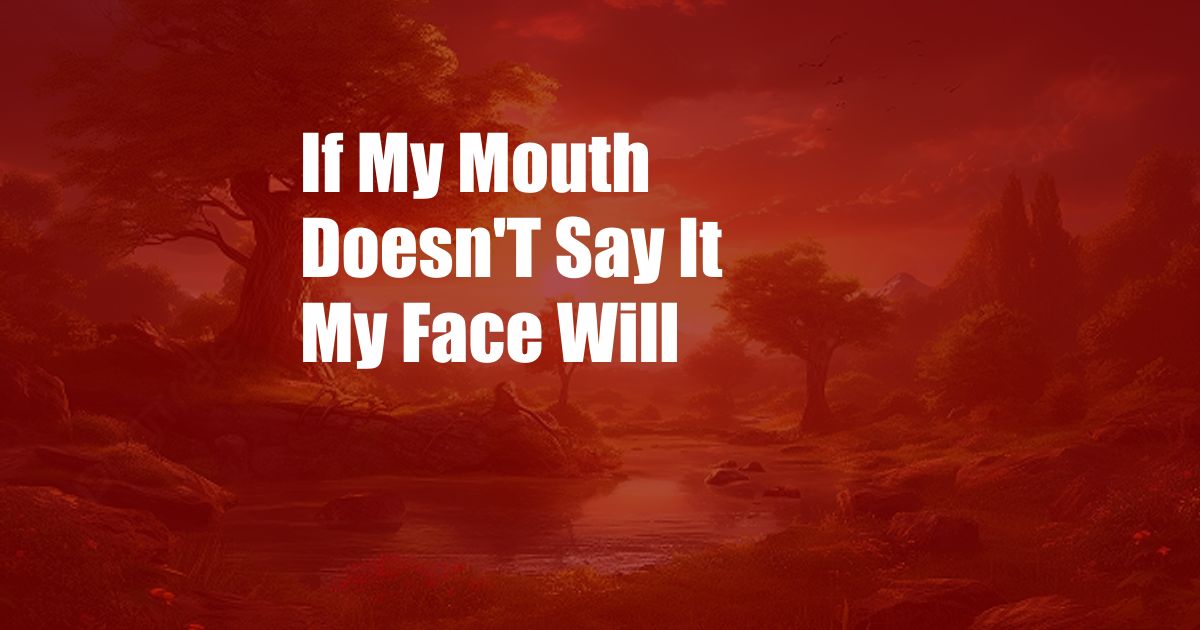
If My Mouth Doesn’t Say It, My Face Will
In the myriad interactions we have each day, words often fail to capture the depth and nuance of our emotions. Our faces, however, become a canvas upon which our true feelings are expressed, often revealing what our tongues may try to hide. The adage “If my mouth doesn’t say it, my face will” encapsulates this phenomenon.
The human face is a complex and expressive masterpiece, capable of conveying a vast array of emotions through subtle shifts in muscles. From the furrowed brow of concern to the radiant smile of joy, our faces betray our inner selves with remarkable accuracy. This nonverbal communication plays a crucial role in our social interactions, helping us to connect with others on a deeper level.
The Power of Facial Expressions
Facial expressions are an integral part of human communication, conveying emotions that words alone cannot fully express. They provide a window into our inner thoughts and feelings, allowing others to understand our emotional state even when we remain silent. Research has shown that facial expressions are universal, transcending cultural boundaries and enabling us to communicate with people from all walks of life.
Our faces are capable of expressing a wide range of emotions, including happiness, sadness, anger, fear, surprise, and disgust. These expressions are triggered by specific neural pathways in the brain, which activate different muscle groups in the face. The resulting combination of muscle movements creates the characteristic facial expressions associated with each emotion.
Interpreting Facial Expressions
While facial expressions are universal, their interpretation can vary depending on context and cultural factors. For example, a smile can convey happiness in one culture but embarrassment in another. Additionally, individual differences in personality and social experiences can influence how we interpret facial expressions.
To accurately interpret facial expressions, it is important to consider the context of the interaction, the other person’s body language, and their cultural background. Paying attention to these cues can help us to better understand the emotions being expressed and respond appropriately.
Tips for Expressing Yourself Nonverbally
Just as we can interpret the facial expressions of others, we can also use our own faces to communicate our emotions effectively. Here are some tips for expressing yourself nonverbally:
- Be mindful of your facial expressions: Pay attention to how your face is conveying your emotions and make adjustments as needed.
- Practice expressing different emotions: Engage in role-playing or practice in front of a mirror to improve your ability to express emotions nonverbally.
- Consider your audience: Be aware of the cultural and contextual factors that may influence how your facial expressions are interpreted.
Expert Advice on Nonverbal Communication
“The face is the mirror of the mind, and the eyes are its windows.” – Marcus Tullius Cicero
“Nonverbal communication is often more powerful than verbal communication. It can convey emotions, attitudes, and intentions that words cannot.” – Albert Mehrabian
These quotes from renowned experts in communication highlight the importance of nonverbal cues, particularly facial expressions, in conveying our thoughts and feelings. By understanding and harnessing the power of nonverbal communication, we can enhance our interactions with others, build stronger relationships, and express ourselves more effectively.
FAQ on Facial Expressions
Q: Are facial expressions universal?
A: Yes, the basic facial expressions associated with emotions such as happiness, sadness, anger, fear, surprise, and disgust are universal across cultures.
Q: How can I improve my ability to interpret facial expressions?
A: Pay attention to the context of the interaction, the other person’s body language, and their cultural background.
Q: Why is nonverbal communication important?
A: Nonverbal communication, including facial expressions, conveys emotions and intentions that words cannot, enhances our interactions with others, and strengthens relationships.
Conclusion
The adage “If my mouth doesn’t say it, my face will” underscores the undeniable power of facial expressions in conveying our emotions and thoughts. Our faces are a reflection of our inner selves, revealing the depth and complexity of our feelings even when words fail us. By understanding how to interpret and express facial expressions effectively, we can enhance our communication skills and build deeper connections with others.
Are you interested in learning more about the fascinating world of nonverbal communication? Share your thoughts and questions in the comments below.